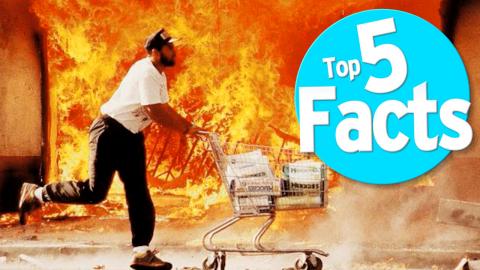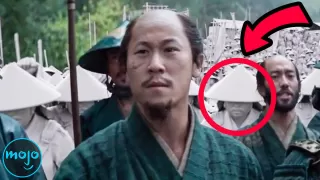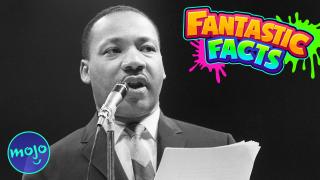Top 5 LA Riots Facts

Often referred to as the Los Angeles uprising, the LA riots of 1992 represented a brief hiatus from civility, and the rule of law. Welcome to WatchMojo's Top 5 Facts. In today's installment, we'll be providing you five insightful facts about a famous historic event: The LA Riots of April 1992.
Top 5 LA Riots Facts
10 Fascinating Facts About the Making of Shogun
Often referred to as the Los Angeles uprising, the LA riots of 1992 represented a brief hiatus from civility, and the rule of law. Welcome to WatchMojo’s Top 5 Facts. In today’s installment, we’ll be providing you five insightful facts about a famous historic event: The LA Riots of April 1992. Like all things race-related in America, this is event is complex and multi-layered, and to fully understand it would take a lot more than just a few minutes. Nevertheless, we hope that this video can at least serve as an overview and introduction to this tragic chapter in history.
5. The Riots Were Sparked by the Outcome of the Rodney King Trial
On the evening of March 3, 1991, 26-year old Rodney King was pulled over after a high-speed chase with police along the Foothill Freeway in Los Angeles. A confrontation with officers followed. King was punched, kicked, stomped on and brutally attacked with tasers and batons by four members of the LAPD. The beating was caught on tape by local resident George Holliday, whose footage would then be broadcast on national television, sparking outrage across the country. In fact, the footage of the attack created such a media circus in LA County that the ensuing trial of the four officers led by the Los Angeles district attorney, was moved to neighboring Ventura County. A jury of nine white, one Latino, one Asian and one biracial male resident acquitted all four officers of assault. One member of the crowd at the Simi Valley Courthouse equated the verdict to “lighting the fuse to a bomb”.
4. Much of the Korean Community Was Left to Fend for Themselves
The riots following the King verdict escalated so quickly and aggressively that LA county police were unable to contain the violence. This lack of resources combined with the complex sociocultural and racial issues of early 90’s LA left Korean communities in an extremely vulnerable position.According to the LA Times, the perception of this ethnic group as a “model minority” fueled attacks from mobs of other minority groups. For their own part, some Korean business owners took matters in their own hands, and armed themselves with rifles and handguns to defend their livelihoods. Although lives and businesses were lost, Koreans now look at the riots, or Sa-i-gu as it has come to be known, as a turning point for Asian American communities in Los Angeles. The violence prompted the formation of activist organizations such as the Association of Korean American Victims. What’s more, the isolation they felt throughout the riots forced an expansion of Koreatown – geographically and culturally. For many Korean Americans, their identities in America were reborn in April of 1992.
3. The Riots Cost the City over $1 Billion in Damages
The LA riots began just minutes after the King verdict was announced. From the LA County courthouse to downtown, looters destroyed storefronts and burned businesses to the ground. This chaos would continue for five more days before US Marines and National Guard were brought in to restore order. By this time, there had been 55 deaths, 2000 people injured and over 11000 arrests made for assault, looting and arson resulting in a combined total of over 1 billion dollars in property damage; the most costly riot to date by over 600 million dollars. While the city’s coffers were taking a beating, gun shop owners were seeing more people walk into their stores than ever before. More than three months after the pandemonium ended, gun sales were still at an all-time high as first-time gun owners worried about another riot situation developing.
2. King's Second Trial Had Two Black Jurors
Martin Luther King Jr. Day! - Fantastic Facts
The state-led prosecution of the officers who aggressed King was controversial from the outset, and not just because of the sensational video evidence. The lack of any black jurors in the trial just added to the public’s perception that systemic racism had prevented justice from being served served. In February of 1993, The United States Department of Justice responded to this outrage by seeking out grand jury indictments of the four officers for violations of King’s civil rights. This time, there would be 2 black jury members. It had only been a year since the riots and the city of LA was still recovering from severe property damage and turmoil. Two of the four officers were found guilty and sent to prison. In a subsequent civil suit against the city of Los Angeles, King was awarded $3.8 million in compensation for his injuries.
1. The Riots Exacerbated Tensions Between Other Minorities
Stereo Riots Restless Radar
Cases of police brutality and excessive use of force usually create a rift between civilians and law enforcement. In the LA Riots however, the rift was split a number of ways. A mob of black people were reported to have dragged white truck driver Reginald Denny out of his truck at an intersection and beat him to within an inch of his life. Guatemalan immigrant Fidel Lopez was also pulled from his vehicle, robbed, beaten and spray painted with black paint. Elsewhere in LA, a 15-year-old black girl named Latasha Harlins was shot and killed by a Korean store owner who suspected Harlins of trying to steal a bottle of orange juice. Upon trial, the store owner was found guilty of manslaughter but was handed a reduced, probationary sentence that further exacerbated tensions between Blacks and Korean-Americans. 65 percent of all the stores vandalized in the riots were Korean-owned, according to estimates from the LA mayor’s office. Analyses of the entire event have concluded that while King’s verdict is what sparked the riots, the inner city conditions of segregation, economic despair and lack of opportunities had been fuelling a deep frustration among minorities for some time. So, what did you think the legacy of this chapter has been? And what do you find most fascinating about these events? For more systematic Top 10s and probationary Top 5s published every day, be sure to subscribe to WatchMojo.com.




